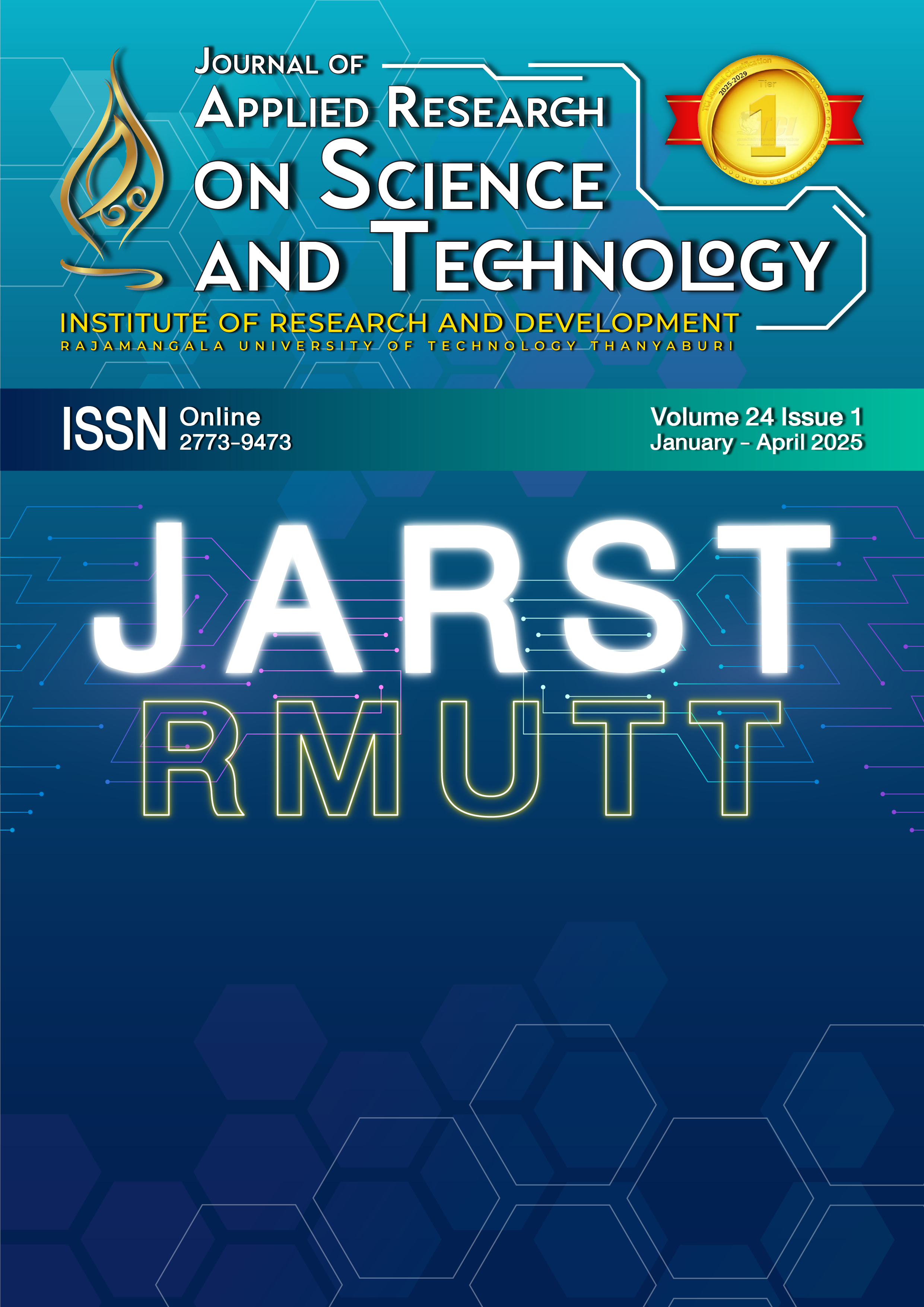Effectiveness of separated ICR for a wheeled skid-steering robot
Main Article Content
Abstract
The skid-steering robot has gained popularity due to its mechanical simplicity and robustness, making it a preferred choice in various applications. However, this configuration is prone to slip during turning maneuvers, resulting in inaccurate trajectory prediction using the conventional differential drive kinematic model. The separated instantaneous centers of rotation (ICRs) approach has been proposed to address this issue and mitigate slips experienced during turns. Compared to the computer simulations, this study investigates the trends of the separated ICR approach on the trajectory error using a real-world robot across different terrains in low dynamic conditions. The findings reveal that the effectiveness of the separated ICR approach in compensating for slip varies depending on the turning radius. Specifically, the approach is less effective with smaller turning radii and vice versa. Surprisingly, the terrain type does not significantly impact the effectiveness of the separated ICRs approach, suggesting that its performance is more closely linked to the turning radius than to the terrain conditions. Although the simulation method outlined in this research struggles with precise surface roughness estimation, it demonstrates consistent skid behavior, indicating the potential utility of separated ICRs for skid-steering robots. To enhance the accuracy of computer simulations, a deeper exploration of terrain surface conditions is necessary. Nonetheless, the implementation of separated ICRs on our four-wheel mobile robot shows promising results, underscoring the viability of using separated ICRs to improve the performance of skid-steering robots in various settings.
Article Details

This work is licensed under a Creative Commons Attribution-NonCommercial-NoDerivatives 4.0 International License.
References
Wang T, Wu Y, Liang J, Han C, Chen J, Zhao Q. Analysis and Experimental Kinematics of a Skid-Steering Wheeled Robot Based on a Laser Scanner Sensor. Sensors [Internet]. 2015;15(5):9681-702. Available from: https://doi.org/10.3390/s150509681.
Maclaurin B. Comparing the steering performances of skid- and Ackermann-steered vehicles. Proceedings of the Institution of Mechanical Engineers Part D Journal of Automobile Engineering. 2008;222:739-56.
Huh S, Lee U, Shim H, Park JB, Noh JH, editors. Development of an unmanned coal mining robot and a tele-operation system. 2011 11th International Conference on Control, Automation and Systems; 2011 Oct 26-29.
Fernandez B, Herrera PJ, Cerrada JA. A Simplified optimal path following controller for an agricultural skid-steering robot. IEEE Access. 2019;7:95932-40.
Cheein FAA, Carelli R. Agricultural robotics: Unmanned robotic service units in agricultural tasks. IEEE Industrial Electronics Magazine. 2013;7(3):48-58.
Liu G, Liu Y, Zhang H, Gao X, Yuan J, Zheng W. The kapvik robotic mast: An innovative onboard robotic arm for planetary exploration rovers. IEEE Robotics & Automation Magazine. 2015;22(1):34-44.
Zhang C, Zhan Q, Wang Q, Wu H, He T, An Y. Autonomous dam surveillance robot system based on multi-sensor fusion. Sensors [Internet]. 2020; 20(4):1097. Available from: https://doi.org/10.3390/s20041097.
Mandow A, Serón J, Pastor F, García-Cerezo A. Experimental Validation of a Robotic Stretcher for Casualty Evacuation in a Man-Made Disaster Exercise. In: 2020 IEEE International Symposium on Safety, Security, and Rescue Robotics (SSRR); 2020 Nov 4-6. Abu Dhabi, UAE. p. 241-5.
Campion G, Bastin G, Dandrea-Novel B. Structural properties and classification of kinematic and dynamic models of wheeled mobile robots. IEEE Transactions on Robotics and Automation. 1996;12(1):47-62.
Yi J, Wang H, Zhang J, Song D, Jayasuriya S, Liu J. Kinematic modeling and analysis of skid-steered mobile robots with applications to low-cost inertial-measurement-unit-based motion estimation. IEEE Transactions on Robotics. 2009;25(5):1087-97.
Burke M. Path-following control of a velocity constrained tracked vehicle incorporating adaptive slip estimation. In: 2012 IEEE International Conference on Robotics and Automation; 2012 May 14-18. Minnesota, USA. p. 97-102.
Martínez J, Mandow A, Morales J, Pedraza S, Garcia A. Approximating kinematics for tracked mobile robots. The International Journal of Robotics Research. 2005;24:867-78.
Mandow A, Martinez JL, Morales J, Blanco JL, Garcia-Cerezo A, Gonzalez J. Experimental kinematics for wheeled skid-steer mobile robots. In: Proceedings of the 2007 IEEE/RSJ International Conference on Intelligent Robots and Systems. 2007 Oct 29 - Nov 2; San Diego, CA, USA. p. 1222-7.
Góra K, Kujawinski M, Wroński D, Granosik G. Comparison of energy prediction algorithms for differential and skid-steer drive mobile robots on different ground surfaces. Energies. 2021;14(20):6722.
Martínez JL, Morales J, García JM, García-Cerezo A. Analysis of tread ICRs for wheeled skid-steer vehicles on inclined terrain. IEEE Access. 2023;11:547-55.
Eiammanussakul T. Design and Development of a Wall Climbing Robot with Magnetic Wheels: Chulalongkorn University; 2013.
Miller S. Simscape Multibody Contact Forces Library [Internet]. San Francisco: GitHub; 2014 [updated 2023 Dec 07; cited 2024 Jul 17]. Availability from: https://github.com/mathworks/Simscape-Multibody-Contact-Forces-Library.


